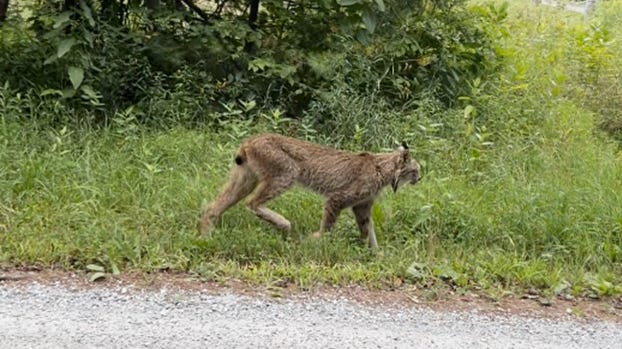In a video taken in Rutland County on August 17, a Canadian lynx was spotted in Vermont for the first time since 2018.
“Canadian lynx are endangered in Vermont and threatened nationally,” said Brehan Furfey, wildlife biologist and fur project manager with Vermont Fish and Wildlife, in a statement. “That makes every confirmed lynx sighting in our state important. This latest sighting is especially exciting because the cat was spotted in Rutland County, well south of most confirmed lynx reports in Vermont.”
Gary Shattuck, a retired federal prosecutor, captured video of the bobcat around 6:30 p.m. as it walked along the side of a dirt road leading to Shattuck's home in Shrewsbury, where he has lived for 50 years.
“I wasn't far from home when I noticed this big cat on the side of the road walking in the same direction (I was driving),” Shattuck said. “I stopped and couldn't tell if it was a bobcat. I was concerned because it looked so thin.”
By chance, 73-year-old Shattuck didn't have his iPhone in his car and drove home to get it. When he returned, the lynx was still walking down the road and Shattuck began recording the video from his car.
“I was curious, I've never been that close to an animal before,” Shattuck said. “I actually expected it to run away, so its behavior was a little strange.”
After filming the video, Shattuck returned home and called the local game warden. His call went to voicemail. The next morning, a Sunday, Shattuck sent the video to the Vermont Fish and Wildlife Department and received an email response within half an hour saying he would receive a call the next day.
Furfey called Shattuck on Monday to confirm that he had captured a rare Canadian lynx on video. The animal's behavior was not unusual for a young male roaming the area. Nor was its appearance unusual, as Shattuck feared the animal was too thin.
“This guy didn't look like a bobcat because he was so thin,” Shattuck said. “I didn't know if he was sick.”
Why are Canadian lynx rare in Vermont?
Vermont lies at the southernmost edge of the Canada lynx's range, Vermont Fish and Wildlife said in a news release, and most confirmed sightings in the state come from the relatively remote Northeast Kingdom near the Canadian border.
“Lynx are specifically adapted to hunt snowshoe hares,” Furfey said. “Both species (lynx and hare) need young forest habitat and reliable snow cover to thrive. In Vermont, the best combination of climate, habitat and enough hares to support lynx is in the Northeast Kingdom, and even that is a rather poor abundance compared to areas in New Hampshire and Maine where lynx are more common.”
Rutland County, where Shattuck videotaped the lynx, is not a suitable habitat for large snowshoe hares, or more accurately, lynx. However, Rutland County has many well-connected wilderness areas that allow wildlife to migrate between different habitats.
Furfe suspects the lynx was a male moving through the region and trying to establish his own territory, a behavior called “dispersing.” Dispersing lynx can travel great distances quickly, and according to Vermont Fish and Wildlife, it's possible the lynx no longer lives in Vermont.
“Although this lynx appears to be on the thin side, its calm behavior toward passing cars, as reported by observers, is not unusual for a roaming specimen,” Furfey said. “This lynx was likely just focused on finding food in an area where rabbits are not plentiful and avoiding competition from bobcats and fisher martens as it traveled through southern Vermont.”
What should you do if you think you see a lynx?
Vermont Fish and Wildlife has received more than 160 reports of bobcats since 2016, but only seven of those sightings have been confirmed. The most recent credible report was in 2018 from Jericho.
“If you think you see a lynx, the most helpful thing to do is take a photo or video and send it to Fish and Wildlife,” Furfey said. “The vast majority of photos our biologists receive are of bobcats, but that doesn't rule out the possibility of a Canada lynx showing up one day.”
Contact Dan D'Ambrosio at 660-1841 or [email protected]. Follow him on Twitter @DanDambrosioVT.



















